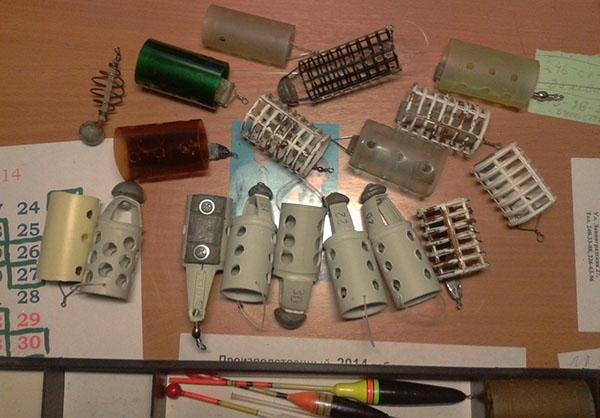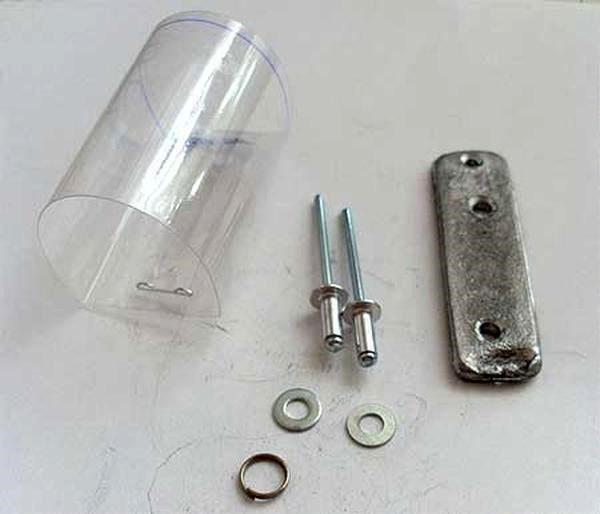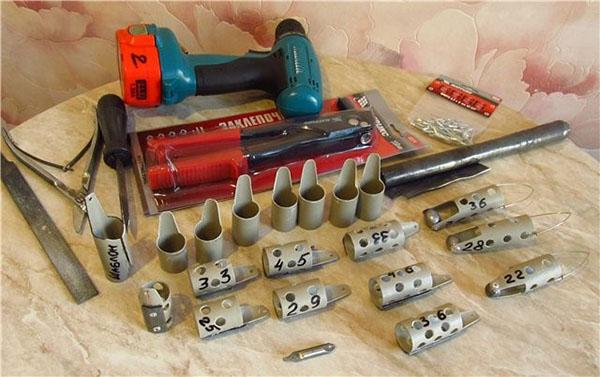How to make the best feeders for feeder fishing?
 Important components of successful feeder fishing are: successful casting and even distribution of bait in the water. And to deliver the bait to the desired fishing point, feeder troughs are used.
Important components of successful feeder fishing are: successful casting and even distribution of bait in the water. And to deliver the bait to the desired fishing point, feeder troughs are used.
Today there are many different models of these devices. You can buy them in the store or make your own. The second option will significantly reduce costs, because feeders are often lost on fishing and you need several of them. Therefore, let's look at the basic ways to make a homemade feeder and attach it to the feeder.
How to make homemade feeder troughs

 Let's take a look at how to make homemade feeder troughs from a standard plastic bottle:
Let's take a look at how to make homemade feeder troughs from a standard plastic bottle:
- Cut off the bottom and neck of the bottle with a knife. We have a plastic cylinder. Then we cut it lengthwise on one side, unfold the finished sheet and lay it out on a flat surface.
- The most optimal size of a plastic feeder is considered to be 6 x 13 cm. We take a marker and mark the holes in a checkerboard pattern.
- We cut out the workpiece, overlap it to make a cylinder and fix it with a stapler or glue.
- Burn out the holes with a soldering iron. They can also be made with a hole punch or drilled out. Some people prefer drilling to prevent deformation of the plastic at high temperatures.
- We put a lead strip on the outside along the length of the feeder, tuck the ends of the lead inward. We securely clamp the loop with the fastening unit with lead. When using such a feeder, it will float up without resistance thanks to the wings formed by the lead plate and plastic.
 Excellent do-it-yourself feeders for a feeder can be made from women's hair curlers. They have a cylindrical shape and already prepared factory holes in the body. If necessary, the size of the trough can be reduced with wire cutters.
Excellent do-it-yourself feeders for a feeder can be made from women's hair curlers. They have a cylindrical shape and already prepared factory holes in the body. If necessary, the size of the trough can be reduced with wire cutters.
To make a feeder from curlers, you need to take products made of high-quality odorless plastic.
 There are also heavy feeder structures that are used for fishing in strong currents. To make them, you need to melt the old lead and pour it into casting molds. When the lead hardens, the mold is opened and lead castings of various configurations are obtained.
There are also heavy feeder structures that are used for fishing in strong currents. To make them, you need to melt the old lead and pour it into casting molds. When the lead hardens, the mold is opened and lead castings of various configurations are obtained.
How to attach a feeder to a feeder
Important components of a feeder rod device with a feeder are:
- main line;
- swivel;
- carbine;
- feeder.
Some anglers assemble the rig on the main line, tying knots and limiting the mobility of the feeder with a stopper. Other fishermen make elements with their own hands using different line thicknesses. And at the same time they make several types of rigs.
 The installation of a feeder for a feeder takes place depending on the type of equipment. Most often, fishermen use the following:
The installation of a feeder for a feeder takes place depending on the type of equipment. Most often, fishermen use the following:
- paternoster;
- symmetrical loop;
- asymmetric loop.
Paternoster, Gardner's loop - most often used for fishing in silt. It can be done in two ways.
The first method - first, at the end of the fishing line, we tie a small loop with a diameter of 2-3 cm.At a distance of 15 cm, we make a second loop with a diameter of about 10 cm so that the feeder will enter into it. Then we pass the line through the rings of the rod.
 The second method - first, at the end of the main line, we make a loop with a diameter of 15-20 cm.Then we cut it into 2 uneven parts (1/2 + 2/3). We attach a swivel to them. Then we mount the feeder to the short line using a carabiner, and a leash to the long line.
The second method - first, at the end of the main line, we make a loop with a diameter of 15-20 cm.Then we cut it into 2 uneven parts (1/2 + 2/3). We attach a swivel to them. Then we mount the feeder to the short line using a carabiner, and a leash to the long line.
 The symmetrical loop is also an uncomplicated, sensitive rig that is made on the main line. First, measure 50 cm of line and fold it in half. At the end of the line, in the folded state, we knit a "eight" knot in a small loop for the leash. Then we take the other end and put a swivel with a carabiner on it. We connect this end and the main line, knot figure eight. Before tying the feeder to the feeder, attach it to the carabiner and attach the leash to a small loop.
The symmetrical loop is also an uncomplicated, sensitive rig that is made on the main line. First, measure 50 cm of line and fold it in half. At the end of the line, in the folded state, we knit a "eight" knot in a small loop for the leash. Then we take the other end and put a swivel with a carabiner on it. We connect this end and the main line, knot figure eight. Before tying the feeder to the feeder, attach it to the carabiner and attach the leash to a small loop.
To avoid twisting the rig at the time of casting, it is often made separately using a harder and tighter line.
 Asymmetric loop - pull a swivel at the end of the main line and knit a large loop with a diameter of up to half a meter. We attach the feeder to the swivel. Then on this loop we tie a small loop 15 cm from the feeder with a figure-eight knot. We fasten a leash with a hook on it, then mount the swivel-carabiner to the other edge.
Asymmetric loop - pull a swivel at the end of the main line and knit a large loop with a diameter of up to half a meter. We attach the feeder to the swivel. Then on this loop we tie a small loop 15 cm from the feeder with a figure-eight knot. We fasten a leash with a hook on it, then mount the swivel-carabiner to the other edge.
Choosing a feeder for different types of reservoirs
Now let's move on to the next question: which feeder troughs are better to choose in order to increase fishing efficiency. In fact, there are several things to consider here. One of the important factors is the strength of the current.
 For low currents, barrels made of plastic and wire mesh are best. They are characterized by excellent aerodynamic properties and ease of filling with feed. These feeder troughs perfectly hold crumbly groundbaits, accurately delivering them to the fishing spot. In addition, they are easy to mount on the rod.
For low currents, barrels made of plastic and wire mesh are best. They are characterized by excellent aerodynamic properties and ease of filling with feed. These feeder troughs perfectly hold crumbly groundbaits, accurately delivering them to the fishing spot. In addition, they are easy to mount on the rod.
But, with all its advantages, such feeders are ineffective in rivers. Because the round shape cannot withstand strong currents and keep the feeder in a lure place.
Feeder troughs for strong currents should be square, rectangular, triangular and supplemented with a heavy sinker. Such feeders perfectly hold the stream. And due to the small cells, the food is washed out slowly, keeping the fish at the fishing point for a long time.
When fishing in a strong stream, it is advisable to use feeders with lugs.
The sinkers of these models have powerful spikes at the bottom, thanks to which the feeders "cling" to the bottom and remain in one place.